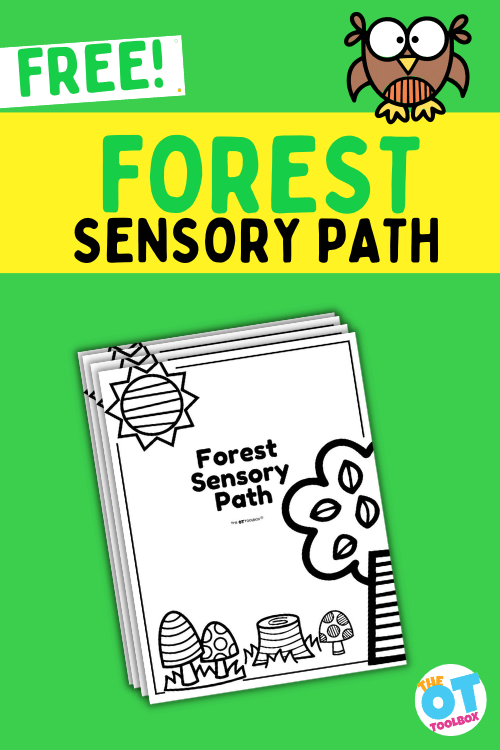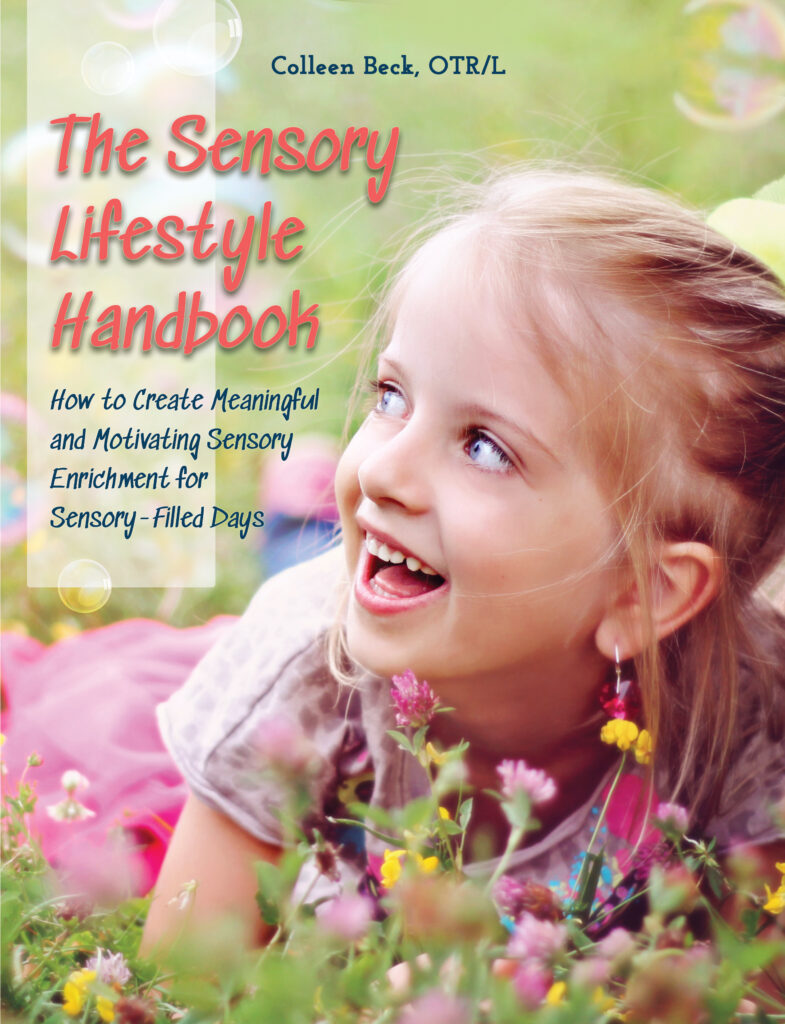If taking a break is a must, but getting outside is tricky, then this Forest Sensory Path hits the mark! We’ve created another fun printable to our collection of free sensory paths with all of the calming benefits of nature and being in the woods. This printable forest sensory walk is perfect for bringing the calming input of nature into the indoors. Be sure to read this resource on sensory nature walks to read up on those calming and organizing self-regulation benefits of woods and nature.

Forest Sensory Path
It seems life is getting more chaotic since the pandemic. This may stem from isolation, lack of exposure, too much electronic use, stressors, or a sudden thrust back into “real life”. Compounding this is the fact that learners do not know how to combat these environmental stressors, or self regulate. It seems learners need instruction on how to take a break. That’s where these Forest Themed Sensory Path stations come in, which provide a structured sensory break, to help reorganize thoughts and body.
Sensory paths and sensory stations became popular with the addition of expensive stickers set up around the school. These are awesome as a self-regulation activity and to address mindfulness with kids! If you don’t have the budget or space for these custom stickers, try one of the sensory walk stations offered by the OT Toolbox.
This month the Forest Sensory Path will fit in perfectly with your fall leaves occupational therapy theme. Add your email below to be sent this FREE download.
How does the FOrest sensory path work?
Sensory activities like this Forest Sensory Walk Station offer tasks to promote body and mind regulation. The initial response to a learner out of sync is to tell them to calm down.
What does “calm down” mean to you? Adults generally have already figured out appropriate strategies to reduce anxiety, inducing a feeling of calm.
Children have no idea what “calm” looks like, because they rarely act this way. They also lack the ability to calm themselves, or know what to do to slow their body/brain down. Having a strategy, movement, or action to stop, self-analyze, breathe for a moment, and take a break from the environmental or internal input, is a literal break for the brain and body. This is where we get the term brain breaks!
Sensory stations provide the framework for self regulation.
Printable Sensory Path: Forest Theme
This Forest Sensory path combines deep breathing and proprioceptive input with eight different activities. Proprioceptive exercise is a “go to” input for organizing the sensory processing system and regulating the sensory systems.
It is alerting for those who are experiencing low arousal, and calming for those who seek additional input to get regulated.
Connected to proprioception and interoception, deep breathing exercises slow the central nervous system, often elevated during periods of fight or flight responses.
The ultimate goal of sensory regulation is self-regulation. Learners need to understand what strategies work for them, and when they are needed. Sensory strategies are unique to each learner.
Just as adults have different routines they use for concentration and focus, children develop varied strategies.
Imagine the additional responsibility teachers take on remembering and learning the sensory needs of each of their students.
When a student can advocate for themselves, this not only helps the student, but their caregivers as well.
How to use the Forest Sensory Paths?
- Lowest level learners need to be taken through the walk step by step
- Middle level learners can be supervised while participating
- Higher level learners will be able to complete this activity when instructed, or advocate for a sensory break
- Laminate the page for reusability. This saves on resources. Caregivers or young learners can help decorate these pages before they are laminated.
- Make this part of a larger lesson plan including gross motor, sensory, social, executive function, or other fine motor skills
- Print in black and white, in color, or on colored paper for different levels of difficulty
- Project this page onto a smart board for students to learn these activities as a group
- More or less prompting may be needed to grade the activity to make it easier or harder.
- Learners can explore other ways they could use this activity
- Explore different options for setting up this sensory station. It could be appropriate in a classroom, hallway, gymnasium, outside the school, or walking into the cafeteria, depending on the needs of your learners
sensory paths for elementary schools
Some of the big budget sensory paths are thousands of dollars and require permanent installation over laminate floors. In many cases, getting approval for the purchase of a sensory path in an elementary school is just out of the question.
The good news is that our printable sensory paths are totally free, AND you can print off the pages and switch out the themes according to the season.
The other benefit that most therapist users see is that the printable pages can be positioned and placed according to the environment. These sensory path pages can be placed in a page protector sleeve and hung in a hallway. Or they can be laminated and placed in a calm down corner. The options are pretty limitless.
A few other common questions about using the Forest sensory path in elementary schools or in therapy clinics can include:
- Do sensory paths work for all learners? No. Sensory strategies are not one size fits all unfortunately. Much of the treatment relies on trial and error. If the forest sensory stations walk does not calm your learner, it is possible the treatment came too late, after the learner was already shut down. Some learners are not able to self regulate through all parts of the sensory stations, however it is a great and simple activity for those who do.
- How long should my learner use a sensory path? There is no defined time frame for any self regulation strategies. Some learners calm quickly, needing a diversion from their current state in order to regulate. Other learners may take several minutes to calm after an upset. Watch for signs of regulation and calming before suggesting your learner stops. After the Forest Sensory Station Walk, take note of how long your learner is able to stay regulated.
- How often should I use a sensory path? Some learners need a boost of sensory regulation every twenty minutes, while others can go several hours before they need a moment to reset. Watch for signs of disorganization and jump in with strategies before meltdown occurs.
- Will a sensory path work consistently every time? Probably not. This worked last week, but not this week. What happened? Sensory strategies are not an exact science. Have a large “bag of tricks” in your toolbox to be able to offer several different strategies.
- How long will the effects of a sensory path last? Every learner is different. A very dysregulated learner may need almost constant strategies for self regulation. A learner who is more organized and has been practicing strategies for a while, might reap the benefits of this sensory stations for two hours. A great sensory workout can have long lasting effects.
- Are sensory paths and sensory stations an evidenced based practice? Because of the nature of sensory dysregulation and the strategies offered, it is very difficult to get consistent data in this area. Use your clinical judgment and observations to determine how effective this Forest Themed Sensory Stations Walk is.
Other Resources from the OT Toolbox
- Summer Sensory Stations
- Winter Sensory Stations
- Christmas Sensory Stations
- Hanukkah Deep Breathing Printable (add this to pieces from the Winter sensory paths and Christmas sensory paths to create a great Hanukkah Sensory Path)
- Fall Sensory Stations
- Spring Sensory Stations
Free Printable Forest Sensory Path
Want to add a forest themed sensory path to your therapy toolbox? Enter your email address into the form below. This resource is also available inside The OT Toolbox Member’s Club. Members can log into their account and access this resource in the Forest Animals Therapy Theme area. Not a member of The OT Toolbox Member’s Club? Join us!

Victoria Wood, OTR/L is a contributor to The OT Toolbox and has been providing Occupational Therapy treatment in pediatrics for more than 25 years. She has practiced in hospital settings (inpatient, outpatient, NICU, PICU), school systems, and outpatient clinics in several states. She has treated hundreds of children with various sensory processing dysfunction in the areas of behavior, gross/fine motor skills, social skills and self-care. Ms. Wood has also been a featured speaker at seminars, webinars, and school staff development training. She is the author of Seeing your Home and Community with Sensory Eyes.
The Sensory Lifestyle Handbook walks you through sensory processing information, each step of creating a meaningful and motivating sensory diet, that is guided by the individual’s personal interests and preferences.
The Sensory Lifestyle Handbook is not just about creating a sensory diet to meet sensory processing needs. This handbook is your key to creating an active and thriving lifestyle based on a deep understanding of sensory processing.







